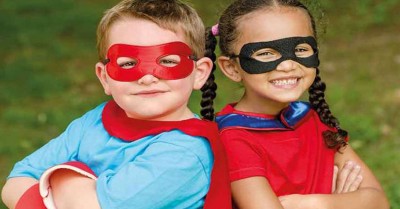Play provides opportunities for children to learn as they discover, create, improvise and imagine. Creative play in children immerse themselves in their imaginary worlds they become whatever they want to be. Also known as role play, and pretend play, the benefits of creative play range from learning to think in abstractions to social and emotional learning. The following article provides ideas and strategies for incorporating creative play in each individual eylf learning outcomes.
Learning Outcome 1 - Children have a strong sense of identity
Engaging in creative play where they get to adopt roles and enact stories of their own making help children develop their emerging autonomy, interdependence, resilience and sense of agency. Educators can help the process further by planning for enough time and space for children to play and imagine like allowing big blocks of time and encouraging efforts that extend over days or weeks. Use moments in the children's pretend play as a gardener or superhero to acknowledge and understand that they construct meaning in many different ways. Above all, display delight and encouragement at children’s attempts to create roles and narratives so that they are supported in developing a strong sense of identity.
Learning Outcome 2 - Children are connected to and contribute to their world
Creative play offers major opportunities for children to learn and practise a variety of social skills. As they imagine themselves to be different people or use various objects, they learn to adopt multiple perspectives. They explore how another person or being may feel and behave in a given situation. Use moments in their role-play of being a family or running a post office to develop a sense of belonging to groups and communities and an understanding of the reciprocal rights and responsibilities necessary for active community participation. Also as you support children in their pretend play, model language that they can use to express ideas, negotiate roles and collaborate to achieve goals.
Creative play also presents great opportunities to feel connected to their environment. Provide children with access to a range of natural materials like stones, shells, flowers, dried leaves, twigs, art prints, fabric and baskets. Use their play in the outdoors or where they pretend to be the sun or clouds for opportunities to discuss the ways elements and beings in the universe are interconnected
Learning Outcome 3 - Children have a strong sense of wellbeing
Pretend play involves action and movement, encouraging children to use their hands, legs and different sense organs. As they imagine themselves to be firefighters, children will climb up ladders and slide down chutes or pretending to be aeroplanes can send them running and whirring through make-believe clouds. Similarly setting up a tea party can build fine motor skills as children use their hands and fingers to dress up their dolls and lay out the table. Educators can facilitate such creative play further by designing learning environments with climbing frames and trim trails that can help children to develop physically and imaginatively. Plan for and support children to participate in energetic play including dance, drama, movement and games which meets an important element of Learning outcome 3,
“Children take increasing responsibility for their own health and physical well-being”
Learning Outcome 4 - Children are confident and involved learners
Creative play can meet this area of learning outcome by providing sensory and exploratory experiences with natural and processed materials. For example, a Mud Kitchen can provide hours of open-ended play as children enjoy dabbing, squelching, squishing and dipping. In order to support creative play further, educators can make available a range of materials that encourage creative expression—for example, paints, blocks, paper, glue, textas, pencils and crayons.
Creative play need not always be content focussed – it can just as well be used as a process. For example, adopt a creative approach to routines— like, collaborating with children to turn lunchtime into a restaurant re-creation. Also, model inquiry processes to try new ideas, improvising equipment and materials—for example, a tee-pee can be conjured up with palm fronds and a few vines. Also if children show an interest in endangered animals, support them to extend the interest to other contexts, creating a board game and then using group work to collect or drew pictures and establish rules. Such play will meet learning outcome elements like, “Children transfer and adapt what they have learned from one context to another”. As children pretend to play a doctor or train engine, educators can use moments to develop children’s involvement in the broader community and environment beyond the early childhood setting.
Learning Outcome 5 - Children are effective communicators
This area of learning outcomes provides particularly rich opportunities for creative play though the most direct reference is in the key component “Children express ideas and make meaning using a range of media”. Creative play can meet this outcome as children imagine and create roles, scripts and ideas. They can use drama time to act out and share stories and symbols of their culture or re-enact stories from their favourite books.
An integral aspect of creative play is music which also meets this learning outcome’s focus on “making meaning using a range of media”. As children act out roles and stories, encourage them to sing and chant rhymes, jingles and songs besides engaging them in play with words and sounds. Design a learning environment that enables children to express meaning using visual arts, dance, drama and music. In this context, musical playground equipment can be fun as it gives them the chance to make music during lessons and playtime.
An important element of Learning Outcome 5 is “Children begin to understand how symbols and pattern systems work”. Creative play is one of the ways that children indicate their readiness for abstract thinking. Children become ready to pretend play when they can think about things as separate from the objects they represent. So a child may use a log – which is a part of a tree – to assign to it another meaning, that of a flying transport. Educators can respond to children’s images and symbols by talking about the elements, principles, skills and techniques they have used in order to convey meaning. This can eventually be extended to discussions on symbol systems, for example, letters, numbers, time, money and musical notation.
Further Reading
Benefits Of Home Corner - The following article lists suggested learning objectives that support a child's overall development in home corner.
How Pretend Play Supports Children's Learning - The following article provides information on ways that pretend play can be a powerful aid to the overall growth of children.
How Children Can Achieve EYLF Learning Outcomes - This is a guide for educators on what to observe under each sub-learning outcome from the EYLF Framework, when a child is engaged in play and learning.
References:
EYLF, Belonging, Being and Becoming, ACECQA
The Need For Pretend Play In Child Development, Psychology Today
UNICEF, Lego Foundation For Learning, UNICEF







 As an Educator in Australia, your pay rate falls under the Children’s Services Award 2010. This award states the minimum amount that an employer can
As an Educator in Australia, your pay rate falls under the Children’s Services Award 2010. This award states the minimum amount that an employer can When working as a qualified Early Childhood Teacher (with a university degree) within a service, your rate of pay will come from the Educational Services
When working as a qualified Early Childhood Teacher (with a university degree) within a service, your rate of pay will come from the Educational Services When working as a Diploma Qualified Educator your pay rate is from the Children's Services Award 2010. This Award states your minimum rate of pay
When working as a Diploma Qualified Educator your pay rate is from the Children's Services Award 2010. This Award states your minimum rate of pay When working as a Cert 3 Qualified Educator, your pay rate is from the Children's Services Award 2010. This Award states your minimum rate of
When working as a Cert 3 Qualified Educator, your pay rate is from the Children's Services Award 2010. This Award states your minimum rate of Educational Leaders play a crucial role in their early childhood service by ensuring that the educational program aligns with best practices and supports the holistic
Educational Leaders play a crucial role in their early childhood service by ensuring that the educational program aligns with best practices and supports the holistic In early childhood education and care, ratios are more than a technicality—they are a frontline safeguard. Every child deserves responsive supervision, emotional connection, and developmental
In early childhood education and care, ratios are more than a technicality—they are a frontline safeguard. Every child deserves responsive supervision, emotional connection, and developmental Here’s a comprehensive Mobile Phone and Smart Watch Policy tailored for early childhood education and care (ECEC) services in Australia, aligned with the latest 2025
Here’s a comprehensive Mobile Phone and Smart Watch Policy tailored for early childhood education and care (ECEC) services in Australia, aligned with the latest 2025 With the new national child safety reforms kicking in on 1 September 2025, early childhood services like yours have a real opportunity to lead the
With the new national child safety reforms kicking in on 1 September 2025, early childhood services like yours have a real opportunity to lead the The Sea of Fish Challenge is a national initiative that invites children, educators, families, and communities to create and display fish artworks as a symbol
The Sea of Fish Challenge is a national initiative that invites children, educators, families, and communities to create and display fish artworks as a symbol Across the early childhood education and care sector, educators are sounding the alarm: current staffing ratios are insufficient to deliver safe, meaningful, and developmentally appropriate
Across the early childhood education and care sector, educators are sounding the alarm: current staffing ratios are insufficient to deliver safe, meaningful, and developmentally appropriate


